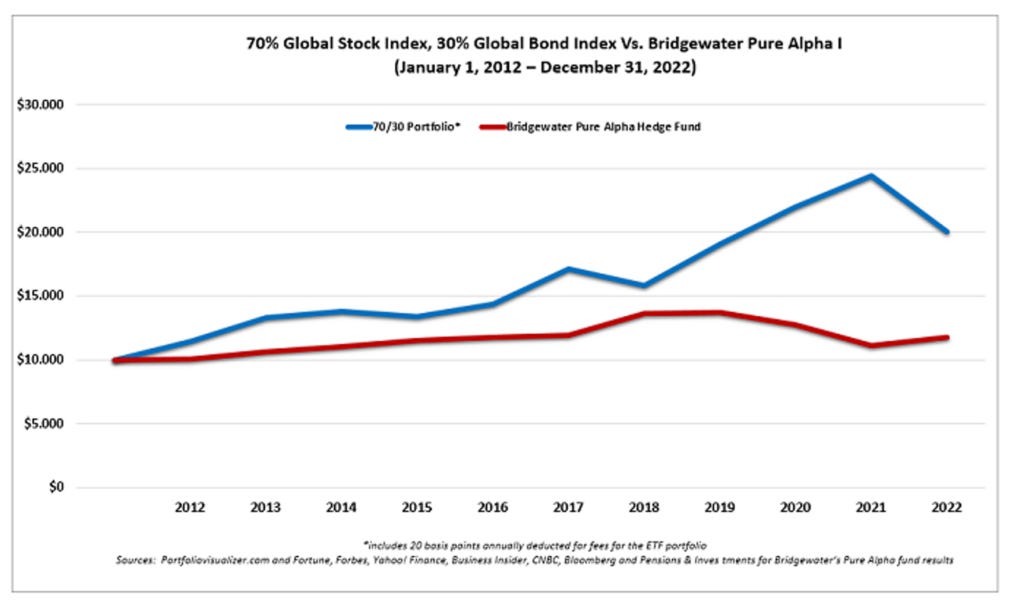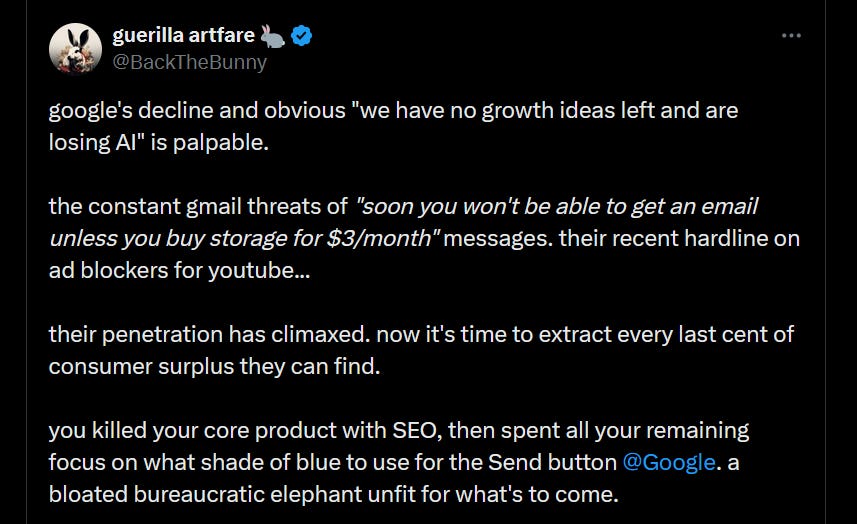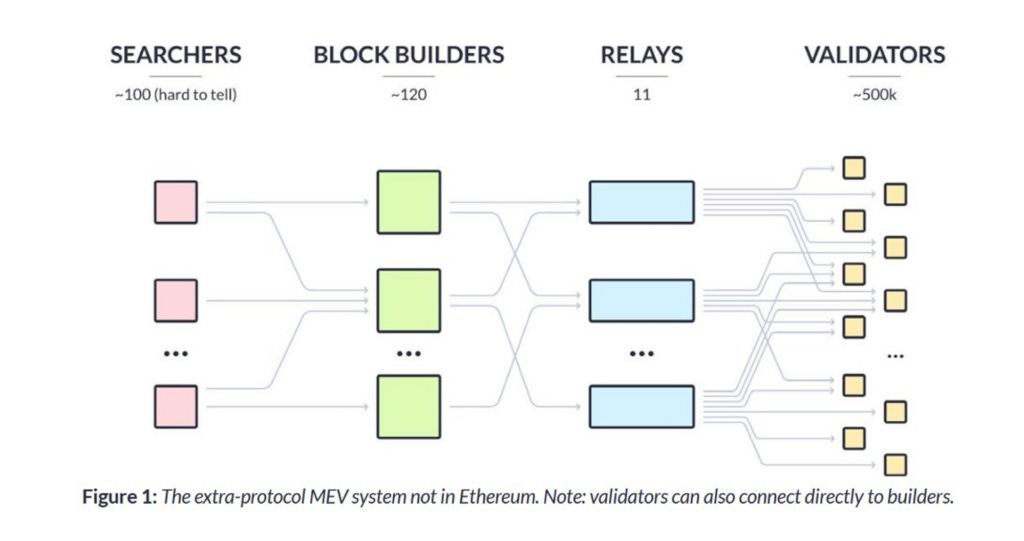Natural Law, Citibank, Elephants, and Ethereum
Blockchains are organisms. Biological law supersedes network law.
I think Ethereum is the most important infrastructure in the world: both for what it is and what it will become. And it will never be enough on its own. There must be other large layer 1s, I believe natural law demands it. Making Ethereum the “mother of all chains” makes DeFi unacceptably fragile. I think there’s plenty of precedence for this. We should want at least 5-6 other L1s that are ~80% ETH's size.
Let’s look to nature and empirical examples of what happens when something grows too large for its own good. Then let’s review the hierarchy of natural laws.
When Your Size Is Too Much Size
A paleontologist named Edward Cope observed that species tend to increase in size over time. It’s referred to as Cope’s Rule, however it’s more accurately viewed as a principle since it’s not universally true. It carries important implications for evolutionary patterns.
The Darwinian motivation for Cope’s Rule isn’t straightforward. Some hypothesize that greater size confers survival advantages: better thermoregulation, access to more food sources, less natural predators, etc.. A logical question then is why isn’t everything the size of Godzilla? If bigger is better from an evolutionary standpoint, why doesn’t everything trend towards gigantic?
Nature abhors a vacuum and a disequilibrium. There is always too much of a good thing, and there’s a Laffer Curve for size; beyond a certain threshold you move from increasing robustness and strength to enhancing fragility. When something gets too large, nature makes it easier to kill. The Tower of Babel is a biblical story that’s scientifically false but Darwinianly true: when you build a structure so large and complex that it tries to reach the heavens, it breaks. Nassim Taleb has made an entire career out of basically illustrating biblical allegories in modern terms with practical evidence.
The Drawbacks of Size: The Elephant and the Ant
With more bulk, you need more resources to live; this narrows where you can exist based on food availability. You move more slowly with all that heft, which restricts your dietary options. Remember, being at the top of the food chain only means you have no predators above you, it doesn’t mean that animals beneath you willingly let themselves be eaten. You still have to be mobile enough to hunt.
Size takes a toll on forms of ruggedness and trauma resistance. The heavier an animal, the easier it dies from a fall. You can drop an ant over 15,000x its height (~1,250 feet) and it won’t die. Squirrels can be dropped 150x their height. Humans die around 10x our height. If you drop an elephant just 1x its height (~10 feet) it dies.
The bigger you are, the harder it is to reproduce, gestation times take longer. Ant eggs hatch within a couple weeks of being laid. Humans take 9 months. Rhinos 17 months. Elephants take nearly 2 years. Reproduction time is a key component of survival, including your ability to withstand black swans that wipe out large parts of the population. You must be able to quickly respawn.
None of us are ever at the top of the food chain; Mother Nature always holds that distinction. The bigger you become, the more susceptible you are to her scorn. You grow less adaptable, because you’re slower, more delicate, and restricted. This is a recipe for eventual wipeout.
Credit to Morgan Housel for introducing me to Cope’s Rule and some of the examples I use here. He’s a great frameworks thinker.
The Company Organism
Biological laws are not reserved solely for things with a heartbeat; they’re germane to any organism. An organism is a coordinated system that functions as a single entity. It can sometimes be living, but it doesn't have to be. A company isn't just a legal construct that makes a product, it’s an organism. Ethereum isn't just a blockchain, it’s an organism.
These natural laws apply to organisms just as they do to a living species. And companies can suffer similar fates as the falling elephant when they become too massive to manage. If they don’t die from excess size, they become sclerotic, glacial relics that decay under their own weight. Let’s review examples.
The Great Financial Crisis: When An Elephant Falls
The Great Financial Crisis (GFC) exposed many financial institutions that had grown too large and complex for continued survival. Banks had become oversized elephants that took 4 years to have a baby (parallel: bureaucratic inefficiency). They had to create byzantine exotic financial products to grow profits (parallel: becoming so large food sources are limited).
The Bob Rubin Trade
The Bob Rubin Trade is a tale from the GFC that illustrates the moral hazard and dysfunction a corporation can experience when leadership loses the ability to understand and manage the thing they’re responsible for. When a structure is too complex and disparate to be competently overseen, you get Citibank in 2007.
Former Treasury Secretary Bob Rubin received over $100 million in compensation from Citi in the decade leading up to its failure. Bob and other Citi executives were responsible for the destruction of the pulsating mass that was Citigroup, yet Bob received $100M for producing $25 billion in losses, a ~90% decline in share price, and a $45 billion intervention from the government… over about 90 days.
How did Citi manage to lose so much? A lot of exotic debt products. A major one was “liquidity puts”, which allowed investors to sell bonds back to Citi at face value should they become illiquid. When things got illiquid, Citi was eviscerated. How does this occur with such prestigious minds guiding the ship?
Per Rubin: "The answer is very simple, it didn't go on under my nose. At Citi, as in any large company, you have people who are specifically responsible for certain areas - trading and risk, for example - and you have senior management monitoring their work. I am not senior management. I have this side role."
Ahh yes, you get paid $100M for a “side role”! Everyone has a big prestigious position and is responsible for the success when things go well, but have merely a “side role” when shit hits the fan. Many such cases!
What about the liquidity puts? Surely such a profitable product must have been something the board was aware of? Rubin says he had never heard of liquidity puts “until they started harassing Citi last summer.” Neat!
It’s called the Bob Rubin Trade because Bob got to keep every cent of that $100M he was paid, despite his decisions contributing to Citi's demise. Nothing was clawed back. He privatized his profits, and socialized his losses. Quite the trade!
The thing is, there’s some honesty to Rubin being oblivious. Citigroup was the 14th largest company globally in 2007, had $146B in revenue across a huge array of products, operated in 160 countries, and at around 381,000 employees had more people to manage than the entire populations of cities the size of Cleveland or New Orleans (both of which have multiple pro sports teams). Citi was enormous.
Any organism Citi’s size will have behaviors that are fundamentally unable to be managed due to its intricate complexity, which leads to obfuscation. If the business is high risk with labyrinthine financiering, you have an elephant standing on the precipice of a 10-foot ledge to contend with.
The complexity and tail risk of the business matters in respect to the risk that accompanies its size. For example: Apple in 2023 had ~164k employees and ~$400B in revenue, which is gargantuan. But there isn’t a “liquidity put” equivalent for Macbooks and iPhones. Apple doesn’t have a product that can destroy Apple within 3 months, whereas Citi did.
Apple is smaller in some ways compared to 2007 Citi, bigger in others; but more importantly there's no fat-tail product that if it fails will bankrupt it.
As size increases:
- Financialized, complex businesses with fat-tail scenarios have wipeout risk (Citi, Ethereum, LTCM)
- All other businesses have decay risk
Bridgewater, Berkshire, and Google: When Size Drags You Down
Warren Buffett has been candid that Berkshire will likely underperform over short-to-midterm time frames because the capital it must deploy to move the needle is too great to beat the market anymore. Berkshire’s limited to a small investable universe of companies that can support the size of stake it requires. Berkshire has less food to eat because it’s so mammoth.
The bigger an investment vehicle gets, the more constrained it becomes. Ray Dalio’s Bridgewater is the biggest hedge fund in the world at $240B, and at that size you pretty much are predestined to underperform every index. And not just a little under performance, Bridgewater has provided investors a 1.5% per year return since Jan 2012. This is basically the same as the inflation rate. Sad!
On Google
The rapid-fire progress of OpenAI and Midjourney has run circles around gargantuan Google. Is Google being left in the dust because it has less intellectual talent? Less resources? Certainly not, in fact Google has tons more resources than its competition, and they’re focused on AI as much as anyone. Google’s failure won’t be catastrophic like Citi’s, but rather a slow bleed to Sears-esque irrelevance. Taken out by the agility of startups.
Google’s failure won’t be catastrophic like Citi’s, but rather Kodak-tier degradation, predicated on its size and bureaucratic ossification. It will continue losing ground to the hypermobility and agility of startups. Speed kills.
The Blockchain Organism
At this point, I think the takeaway for Ethereum — and any sufficiently complex, large organism — should be apparent.
Ethereum is much closer to Citi complexity and risk than Berkshire or Google. The latter two will become stagnant, mediocre, and slowly fade. Whereas Citibank nearly took down the entire global financial system and died all at once when the laws of biology came knocking on its door.
If Ethereum becomes what we all think it can be, it will be orders of magnitude more critical and complex than Citi. In fact it may already be getting there.
Nodes, block builders, relayers, validators, and massive amounts of capital and infrastructure flowing atop it will create a network so powerful it will likely be without precedent.
Above a certain dominance, this is a threat to DeFi.
If Ethereum owns a supermajority of DeFi capital and activity, it will make DeFi fragile. This cannot be programmed or network effects-ed away. Ethereum will be ruled by biological laws, and too much size imperils the DeFi system as a whole. Because Ethereum is an organism, and network laws are subordinate to biological laws.
The intellectual firepower in DeFi is possibly the best in the world… but we should humble ourselves, we have not out-engineered God. Our organism is not immune from natural law and the dictates of biology. We should learn from the hard lessons of the past. To create the most robust, functional, persistent crypto ecosystem, Ethereum should probably have no more than 30% of total DeFi TVL. We should want 5-6 other competitive L1s with their own validators, security, settlement, etc.. to distribute risk and support our new financial world.
We recognize that if every Ethereum validator runs the same client (eg Geth) it presents an intolerable risk to the network, so much so that you see ETH clients encouraging the use of their competition for the health of the overall network. So too should we promote the adoption of other Layer 1s for DeFi's health.
Don’t view other chains as competition, view them as brothers developing and securing our new global system. Stronger together.
A Hierarchy of Natural Laws
My thesis on Ethereum and size risk contradicts network power laws that basically say the strength of a network increases as its participants do. Network laws disagree with me, but biological ones do. Network laws are not unstoppable forces that supersede other laws of nature, namely biological ones. I think there’s a hierarchy to natural laws; this is how I view them.
There are laws of physics, laws of biology, and laws of networks.
Respectively, this translates into:
laws about how the world works (physics)
laws about how living things in the world work (biology)
laws about how living things in the world organize themselves (networks)
I believe all natural axioms can fundamentally be placed into one of these three categories. Examples:
Newton’s 2nd law, thermodynamics, etc. are physics laws.
Central Dogma, Law of Segregation, etc. are biological laws.
Metcalfe’s Law, Reed’s Law, are network laws.
Other disciplines fit into these categories. For instance I’d put math in “laws about how the world works”.
What makes one group of laws superordinate to another? And why rank these laws?
Well, what if network laws and biological laws contradict each other like they do in my piece here… which one is the dominant law?
Physics being the highest-order set of laws felt intuitively correct to me. Reflecting on why, I realized it’s because the other two sets of laws report to it for guidance, and have no say in how it operates.
Physics influences biology. Biology does not influence physics.
Biology influences networks, networks do not influence biology.
Influencer > Influencee
Thought experiment: imagine the laws of physics changed, what would happen? Living things would have their existence dramatically altered, the way they experience reality would change based upon the changes in physics. Biology would change if physics did and would follow its instructions.
Now imagine if biological laws broke, physics would be unaffected. If there was a complete suspension of the rules that govern living things, the laws of thermodynamics or gravity would remain intact. Newton's 3rd Law doesn’t care if humans grow to the size of skyscrapers.
Now picture if network laws fractured… biology and physics would be indifferent. If a network law was violated, the way your body worked would not be affected. Network laws have zero impact on biology or physics, whereas biology and physics impose their will on networks.
I believe this is how you determine the hierarchy of natural laws and which ones are superordinate: who dictates to who.
Natural law can be broken into three categories and their hierarchical ranking is predicated on whether a change in one set of laws would result in other laws being altered.
This law-ordering system was something I thought about while writing this piece. Thoughts and feedback welcome.
Please subscribe and share if you enjoyed.
Follow @BackTheBunny










I think the challenge with your scale analogy is that you used companies instead of governments, and profit as the measure of power, instead of power/ability to survive. Also, L2s may solve some of the 'Eth is too big' challenge.
For the biology, Cope is full of crap. Species do not trend towards larger size with time. Size depends on niche and resource availability. In cold weather niches, larger size = smaller surface area to mass ratio = less heat loss. On the other end of the spectrum, microsporidia are as "evolved" as we are, and they gave up many basic organelles to optimize their parasitic lifestyle. Goldfish grow until they fill their tank/food limits, but an eagle kept in the largest cage possible with all the food it wants will never grow big enough to carry you away from Mt Doom.